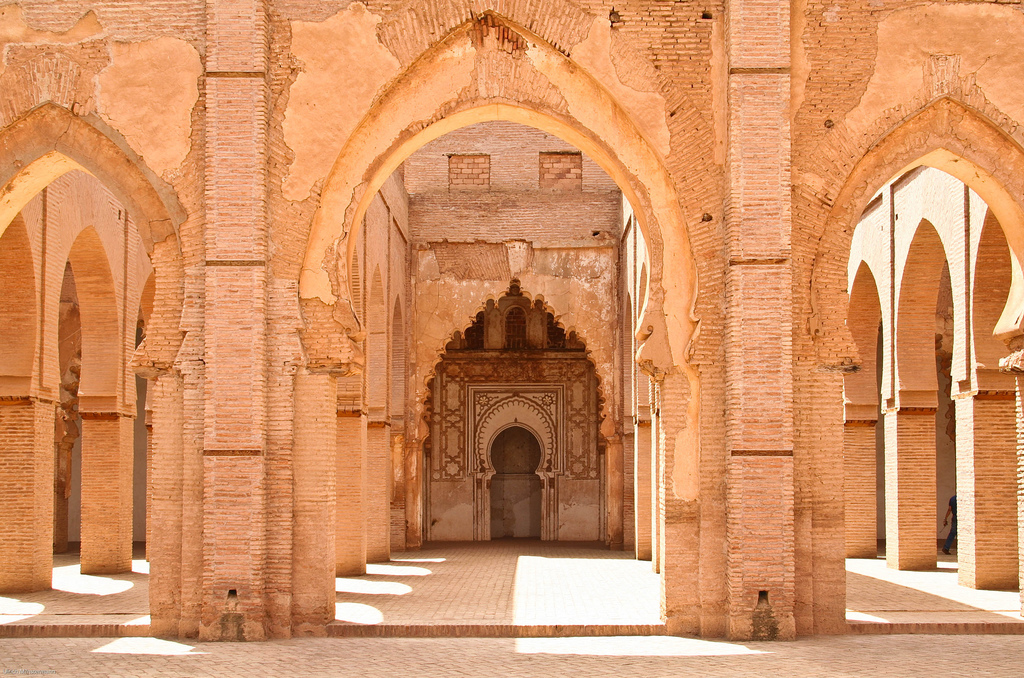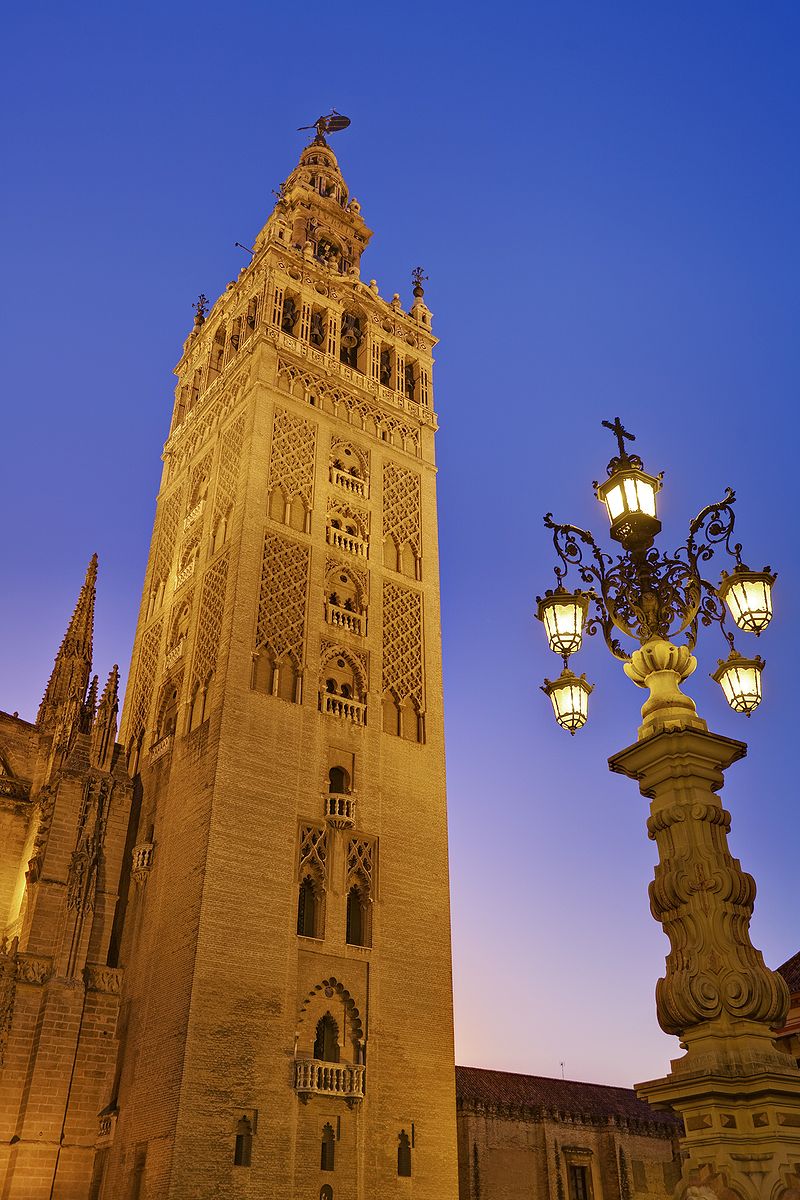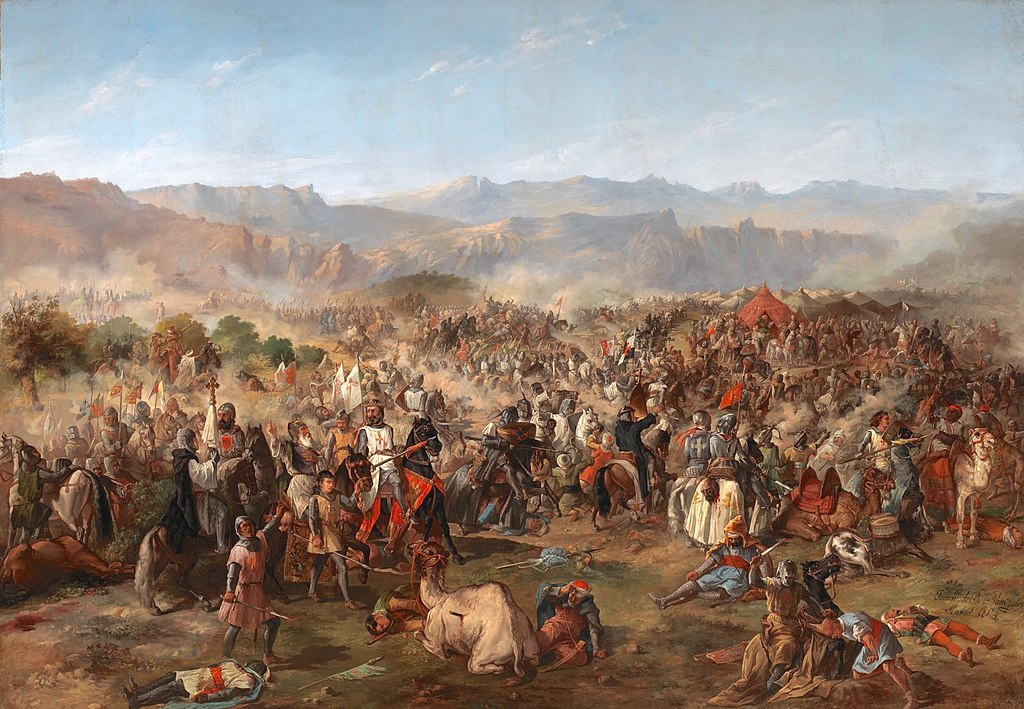Ali ibn Yusuf is said to have been a 100 years-old when he died in 1106, and nine years before his death, he had assumed the title of Amir al Muslimin. (Lord of the Muslims) Almoravid power under Yusuf had reached its height, and its empire then included all of Northwest Africa as far eastward as Algiers and more than a thousand kilometres of Atlantic African coastline. They controlled all of Iberia south of the Tagus, and as far eastward as the mouth of the Ebro, including the Balearic Islands.
Yusuf had appointed his brother, Tamim Al Yusuf, as his successor, and it was he who continued the fight against the Christians in al-Andalus. In 1108 he defeated the forces of Castile and León under Alfonso VI at the battle of Uclés just south of the river Tagus. Many of the high nobility of León, including seven counts, died in the fray or were beheaded afterwards, while the heir-apparent, Sancho Alfónsez, was murdered by villagers while trying to flee. The Almoravids again failed to go on and take their biggest prize, the city of Toledo.
Tamin’s son and successor, Ali ibn Yusuf, was occupied with insurrection in Morocco and it was 1119 before he could return to al-Andalus to deal with a Christian uprising in Córdoba as well as renewed attacks on his northern borders with Christendom. He returned in 1121 and as soon as he arrived he realised that he was facing a different level of threat. The French had joined forces with the Aragonese to take Zaragoza, and in 1138 his army were defeated by Alfonso VII of León. A year later, he was again defeated by Alfonso I of Portugal at the battle of Ourique. Ali ibn Yusuf died in 1143 and was succeeded by his son, Tashfin ibn Ali, but in 1146 he was killed in a fall from a precipice during a battle near Oran. Pockets of Almoravid rule continued for another 100 years, but they had effectively been replaced by another Berber tribe led by Ibn Tumart, who had begun his rise to power around 1120 in Morocco.
The Almoravids were a Sanhaja Berber tribe, whilst Ibn Tumart was a member of the Masmuda, a Berber tribal confederation in the Atlas Mountains of southern Morocco. As a young man, Tumart travelled to Iberia to pursue his studies, and thereafter to Baghdad to continue them. It was in Baghdad that Tumart began to follow the theological school of al-Ash'ari and came to develop his own theological creed. His followers would become known as the al-Muwaḥḥidūn (Almohads), meaning those who affirm the unity of God.
How the Almohads came to dislodge the Almoravids is quite an amazing story.
From 1117 onwards Tumart travelled to a number or Ifriqiyan cities. He began preaching that the Almoravid rule was lax and straying from the Qur'an. He led attacks on wine-shops and opposed the Maliki school of jurisprudence. His fiery preaching led the authorities to move him along from town to town. Finally, he set up camp on the outskirts of Mellala, where he received his first disciples; Al-Bashir, and Abd al-Mu'min, who would later become his successor. Tumart led his small band of followers to Fez, where he debated with the Maliki scholars, but he was expelled from the city after he allegedly berated the sister of the emir for not wearing her veil in the street.
In Marrakesh he sought out Emir Ali ibn Yusuf in a mosque and challenged him and his scholars to a doctrinal debate. The emir agreed, but after the debate the scholars decided that Tumart’s views were blasphemous and that he was dangerous. They urged the emir to have him put to death or imprisoned, but the emir wisely decided to simply throw him out of the city.
Tumart went back to his home village of Igiliz in the Sous valley and hid among his own tribe, the Hargha. He became a hermit, and lived in a cave, only coming out to preach his program of puritan reform. His following grew, and in late 1121, he gave a particularly moving sermon explaining that he could not reform the ruling Almoravids by argument alone. He then declared himself as the true Mahdi; a divinely guided judge and lawgiver. He was urged by his followers to move into the High Atlas Mountains among the Masmuda tribes where his support grew, and where he set up the ribat of Tinmel, an impregnable fortress which would be the future headquarters of the Almohad movement.
 The mosque at Tinmel
The mosque at Tinmel
From this base he dominated the western end of the trans-Sahara trade route and its terminus, Sijilmassa. Despite attempts to dislodge him, the Almorovids could not pin his forces down, and they sought alternative routes for trade. But it was the social structure of the base that made it revolutionary. The core was Ahl ad-dār (House of the Mahdi), composed of Ibn Tumart's family. This was supplemented by two councils: an inner Council of Ten, the Mahdi's privy council, composed of his earliest and closest companions, then the consultative council of fifty, composed of the leading sheikhs of the Masmuda tribes. It had a military hierarchy organised along the same lines, with an administrative branch for tax collection and control of finances. Finally Tumart's closest companion and chief strategist, al-Bashir, took upon himself the role of "political commissar" enforcing doctrinal discipline among the Masmuda tribesmen.
It was 1130 before they felt confident enough to come out of the mountains and make their first sizable foray against the Almoravids. They scattered the column that came out to meet them and chased them all the way to Marrakesh, where they laid siege to the city for forty days. Finally, the Almoravids stormed out and crushed the Almohads in the bloody Battle of al-Buhayra. Thoroughly routed, with huge losses, and half their leadership killed in action, the survivors only just managed to scramble back to the mountains.
Ibn Tumart died shortly after in August 1130, and it is a tribute to his well-organised social structure at Tinmel that his movement carried on with a new leader. There was probably a power struggle of some kind, but Abd al-Mu'min, Tumart’s closest friend took command, and in a staggering tour-de-force in the nineteen years between 1130 and his death in 1163, Mu'min not only removed the Almoravids, but extended his power over all northern Africa as far as Egypt, becoming Emir of Marrakesh in 1149. He turned his attention to al-Andalus in 1146 and broke the grip of the Almoravids across Iberia, moving the capital of their rule from Córdoba to Seville. The Torre de Oro on the banks of the old docks was one of many fortifications built by the Almohads.
 Torre de Oro
Torre de Oro
After the death of Mu'min, Abu Yaqub Yusuf (Yusuf I) became emir and ruled from 1163 until his death in 1184. He ordered the construction of a great mosque in Seville, and upon his death, the great minaret, which is now known as the Giralda, was constructed to celebrate the accession of his successor, Abu Yusuf Yaqub al-Mansur. They also built a palace in Seville called al-Muwarak on the site of the modern day Alcázar.
 The Giralda, Seville
The Giralda, Seville
Almohad intolerance in the treatment of Christians and Jews drove many of them out of al-Andalus into the growing Christian states in the north. Over the years, they became less fanatical, but the damage had been done, and the dispossessed became adversaries. The brother of the emir, Abu Yahya, was governor of al-Andalus whilst the emir ruled from Marrakesh, and a truce had been in force with the Christians, but when the emir fell ill in 1194, his brother dropped everything and rushed to Marrakesh hoping to take over as emir.
With al-Andalus ungoverned, Alfonso VIII of Castile attacked Seville. The Christian forces were led by the Archbishop of Toledo and the Order of Calatrava, and they ransacked the province. A fully recovered and furious Abu Yusuf Yaqub returned to Seville the following year at the head of an army with the intention of striking back at the Christians. Having had advance warning, Alfonso gathered his forces at Toledo and marched down to Alarcos, (al-Arak) near the Guadiana River. Yaqub met him there, but rested his forces for two days before engaging the enemy. The battle was ferocious and lasted all day, but in the end, the emir had driven the Christians into the castle at Alarcos and surrounded them. Half of the 3,000 people in the castle were women and children and their leader, Diego López de Haro, Lord of Vizcaya, negotiated for surrender. The survivors were allowed to go, leaving 12 knights as hostages for the payment of a great ransom.
The Castilian field army had been destroyed, and many of the Christian nobles had been killed as well as the knights of the Order of Calatrava. The emir had also lost many of his closest supporters, but he had earned the agnomen of al-Manṣūr, the Victorious. Pope Innocent III considered the defeat such a threat to Christendom that he called to the Spanish, French and Portuguese nobles to mount another crusade.
For the next two years, al-Mansur's forces devastated Extremadura, the Tagus valley, La Mancha and even the area around Toledo. Many of the expeditions against the Christians were led by Pedro Fernández de Castro, a turncoat and enemy of King Alfonso. But the attacks produced no real gains in reclaiming lost territory. However, the Christian kingdoms had been devastated, which led to Navarre proclaiming neutrality, and a peace treaty with King Alfonso IX of León, who had been enraged when the Castilian king had not waited for him before the battle of Alarcos.
The treaties and alliances were all temporary, but good enough for the emir to claim success. Abu Yusuf Yaqub returned to Marrakesh in poor health, and he died there in 1199. Abu named his son, Muhammad al-Nasir as successor. Sixteen years later, the new caliph began a new Iberian offensive, but on the 16th July 1212 he came upon a force that was prepared for his arrival. He was facing the armies of three kingdoms, Castile-Leon, Aragon, and Navarra, plus some Portuguese troops and military orders including the Knights Calatrava and Templar. This force of 50,000 was headed by the King of Castile, Alfonso VIII, assisted by Pedro II of Aragón and Sancho VII of Navarra.
According to legend, a local shepherd named Martin Halaja showed the Christian forces a way to cross the 480km-long Sierra Morena Mountains through a gorge unknown to the Almohads. The attack took the Moors by surprise and allowed the Christians to surround the tent of the caliph, and he narrowly he escaped capture. Nevertheless, the Christian armies had the advantage of surprise against the 200,000 strong army of Nasir. Muslim chroniclers attribute the defeat to the greed of the caliphs, and Andalucian traitors and cowards who were supposed to be fighting for their Almohad rulers. In truth, it was marked by betrayals on both sides. Now known as the Battle of Tolosa, the conflict marked the turning point in the reconquest of Iberia. Historians emphasize the ruthless Christian violence which characterised the battle, and the bloodthirsty cries of King Alonso’s heralds during the battle, “Slay and seize. If you take a prisoner, you will be killed with him."
 This painting of the Battle of Tolosa was painted by Francisco de Paula Van Halen and hangs in the Museo del Prado in Madrid.
This painting of the Battle of Tolosa was painted by Francisco de Paula Van Halen and hangs in the Museo del Prado in Madrid.
When the battle was over, the Christians had routed the Almohad army, and the defeat was to mark the turning-point that led to the end of Moorish rule in the Iberian Peninsula. The Almohad Empire itself collapsed a few years later after internal bickering and multiple power-grabs.